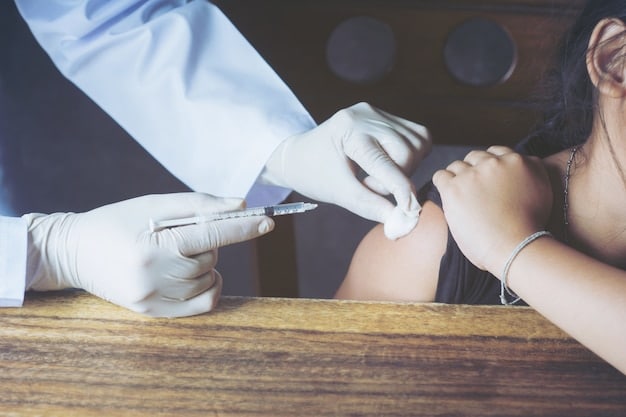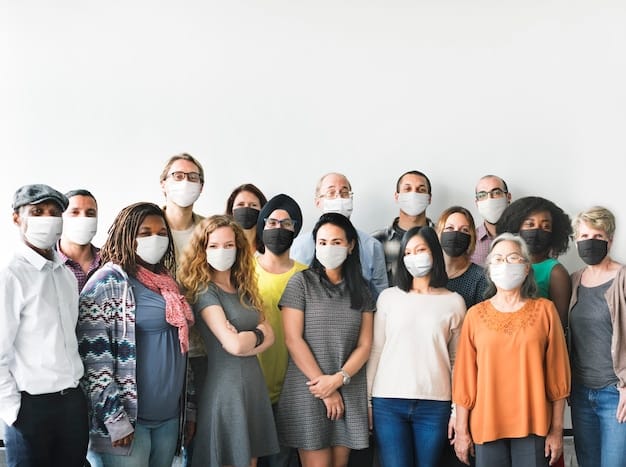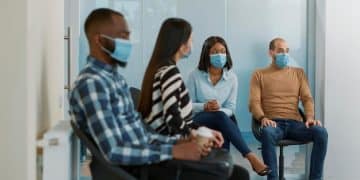Measles cases rising in US: Public health urges vaccination

The United States is experiencing a concerning surge in reported measles cases nationwide, prompting public health officials to issue urgent calls for vaccination to prevent further spread and protect vulnerable populations.
A significant increase in confirmed measles cases across the United States has activated public health alert systems, prompting officials to issue urgent calls for widespread vaccination. This development, highlighted by the critical need for public awareness and proactive measures, underscores the importance of vaccination as a primary defense against infectious diseases like measles.
Understanding the Current Measles Outbreak Landscape
The recent uptick in measles cases nationwide is more than just a statistical blip; it represents a concerning shift in the trajectory of a highly contagious, vaccine-preventable disease. Public health agencies are meticulously tracking these developments, noting clusters of infections in various states, which often trace back to international travel or unvaccinated communities. This resurgence brings to the forefront the challenges of maintaining high population immunity and the vulnerabilities that emerge when vaccination rates decline, even marginally.
Geographic Spread and Hotspots
The outbreak is not confined to a single region but appears as scattered but significant clusters across different states. Identifying these hotspots is crucial for targeted public health interventions. Typically, these areas often coincide with communities where vaccination coverage has been historically lower than the national average, creating pockets of susceptibility. Health departments are working tirelessly to map these areas, implement rapid response strategies, and communicate risk effectively to residents.
Data from the Centers for Disease Control and Prevention (CDC) indicates a sharp increase compared to previous years, challenging the notion that measles was largely eradicated in the U.S. This rise serves as a potent reminder of the disease’s enduring potential if given the opportunity to spread among susceptible individuals. Understanding the patterns of transmission and the demographics most affected is paramount to containing the current surge.
Factors Contributing to the Resurgence
Several factors are believed to be contributing to this sudden rise in measles cases. A key element is the global increase in measles activity, which inevitably leads to imported cases into the U.S. when unvaccinated individuals travel. Once these cases enter communities with low vaccination rates, the virus can quickly spread, particularly within schools, daycare centers, and other close-contact environments.
- Decline in vaccination rates: A measurable dip in routine childhood vaccination coverage has left more children and adults vulnerable.
- Misinformation and vaccine hesitancy: The spread of unverified information about vaccine safety often undermines public trust and encourages non-vaccination.
- International travel: Unvaccinated travelers returning from areas with measles outbreaks can introduce the virus into susceptible U.S. communities.
The combination of these factors creates a fertile ground for the measles virus, a pathogen known for its extreme contagiousness. One infected person can transmit the virus to 9 out of 10 unvaccinated people who are in close contact, highlighting the critical role of herd immunity in preventing widespread outbreaks.
In response to this alarming trend, public health officials are intensifying surveillance efforts, conducting thorough contact tracing for every confirmed case, and deploying rapid vaccination clinics in affected areas. The immediate goal is to break chains of transmission and protect the most vulnerable segments of the population, including infants and immunocompromised individuals, who cannot be vaccinated.
The situation underscores a crucial message: measles is not a benign childhood illness. It can lead to severe complications, including pneumonia, encephalitis, and even death. The public health community is united in its efforts to convey the seriousness of this threat and to encourage immediate action through vaccination.
The Measles Virus: Understanding Its Potency and Risks
Measles, a highly contagious respiratory disease, is caused by a virus in the paramyxovirus family. Its potency lies in its ability to spread rapidly through the air when an infected person coughs or sneezes. The virus can remain active and contagious on infected surfaces or in the air for up to two hours, making transmission incredibly efficient. This high transmissibility means that even brief exposure can lead to infection in unvaccinated individuals.
How Measles Spreads and Symptoms
The measles virus first infects the respiratory tract, then spreads throughout the body. Symptoms typically appear 10 to 14 days after exposure. The initial signs are often non-specific but rapidly progress to the characteristic measles rash. This progression highlights the insidious nature of the virus, as individuals can be contagious for several days before the rash appears, unknowingly spreading the disease.
Symptoms of measles include:
- High fever (often exceeding 104°F or 40°C)
- Cough, runny nose, and red, watery eyes (conjunctivitis)
- Small white spots with bluish-white centers on the inner lining of the cheek (Koplik spots), which appear 2-3 days after symptoms begin
- A rash of large, flat blotches that often flow into one another, starting on the face and spreading down to the rest of the body.
The rash typically lasts 5-6 days. Individuals are contagious from four days before the rash appears to four days after the rash subsides. This protracted period of contagiousness, much of which is pre-symptomatic or mildly symptomatic, makes containing outbreaks particularly challenging.
Potential Complications and Long-Term Effects
While often seen as a childhood disease, measles can lead to severe health complications, particularly in young children (under 5 years old) and adults (over 20 years old). The risks associated with measles are far from negligible, making prevention through vaccination a critical public health priority. The disease can weaken the immune system, leaving individuals susceptible to other infections for months or even years after recovery.
Common complications include ear infections and diarrhea, which, while treatable, can be distressing. More serious complications are also a significant concern, emphasizing the importance of preventing measles rather than treating its consequences.
- Pneumonia: The most common cause of death from measles in young children.
- Encephalitis: Inflammation of the brain, which can lead to convulsions, deafness, or intellectual disability.
- Severe diarrhea and dehydration: Especially dangerous in infants and young children.
- Subacute sclerosing panencephalitis (SSPE): A rare, fatal degenerative disease of the brain that can develop 7 to 10 years after a measles infection.
These severe complications highlight that measles is far from a benign illness. Its potential for long-term debilitation and fatality underscores the vital role of vaccination in protecting not only individuals but also the wider community, especially those who cannot be vaccinated due to age or medical conditions.
The risk of these serious outcomes mandates a robust public health response, centered on vaccination as the most effective preventative measure. The current increase in cases serves as a stark reminder of the virus’s destructive potential when given the opportunity to spread freely.

Urgent Call to Action: The Imperative of Vaccination
In light of the escalating measles cases, public health officials are issuing an urgent, unambiguous call for vaccination. The Measles, Mumps, and Rubella (MMR) vaccine remains the cornerstone of protection against this highly contagious disease. This vaccination is not merely a personal health decision; it is a critical public health imperative that contributes to the collective immunity of communities.
The Efficacy and Safety of the MMR Vaccine
The MMR vaccine is remarkably effective and has an excellent safety record, backed by decades of comprehensive scientific research. Two doses of the MMR vaccine are about 97% effective at preventing measles, and one dose is about 93% effective. This high level of protection is instrumental in preventing outbreaks and maintaining population-level immunity.
The safety of the MMR vaccine has been rigorously studied and reaffirmed by leading health organizations worldwide. Concerns about a link between the MMR vaccine and autism have been thoroughly disproven by numerous large-scale scientific studies. The initial study that suggested such a link was retracted and its author discredited. Public health campaigns consistently emphasize that the benefits of vaccination far outweigh any minimal risks associated with the vaccine itself.
Key facts regarding MMR vaccine safety and efficacy:
- Highly Effective: Two doses provide near-complete protection against measles.
- Proven Safety: Decades of research affirm its safety profile, with potential side effects typically mild and temporary.
- Widely Recommended: Part of routine childhood immunization schedules globally, endorsed by WHO, CDC, and major pediatric associations.
The overwhelming scientific consensus is that the MMR vaccine is both safe and highly effective. Any decision to forgo vaccination not only places the individual at risk but also contributes to the erosion of community immunity, making everyone more vulnerable to outbreaks of preventable diseases.
Who Should Get Vaccinated (or Re-vaccinated)?
The recommendations for MMR vaccination are clear and aim to ensure broad protection across different age groups and risk factors. Understanding who needs to be vaccinated or re-vaccinated is crucial for mitigating the current outbreak and preventing future ones. General guidelines emphasize vaccination for most individuals, with specific considerations for certain groups.
The CDC recommends that children receive two doses of the MMR vaccine: the first dose at 12 to 15 months of age, and the second dose at 4 to 6 years of age. These age ranges are strategically chosen to provide protection early in life and to boost immunity before school entry, where exposure risk can be high.
However, vaccination is not just for children. Adults, particularly those born in 1957 or later, who do not have documented evidence of measles immunity, should also ensure they are vaccinated. This includes:
- Individuals with no documented measles immunity.
- Healthcare workers who are at increased risk of exposure.
- College students and international travelers, due to closer living conditions and potential exposure to global outbreaks.
It’s important for everyone to check their vaccination records. If unsure about their measles immunity status, consulting with a healthcare provider is the best course of action. A simple blood test can determine immunity, and if immunity is lacking, vaccination is strongly recommended. Vaccination helps create “herd immunity,” protecting individuals who cannot be vaccinated, such as infants, pregnant women, and people with compromised immune systems. This collective protection is vital in stopping the spread of highly contagious diseases like measles.
Public Health Strategies for Containing the Outbreak
Public health agencies are employing a multi-faceted approach to contain the current measles outbreak, focusing on rapid response, comprehensive surveillance, and effective community engagement. These strategies are honed from years of experience in managing infectious disease outbreaks, aiming to minimize spread and protect the population.
Enhanced Surveillance and Rapid Response
At the core of the containment strategy is enhanced surveillance, which involves meticulously tracking new cases and potential exposures. This rigorous monitoring allows public health authorities to quickly identify emerging clusters and implement targeted interventions. The speed of response is critical in controlling a highly contagious disease like measles, where every hour counts.
Rapid response teams are deployed to investigate each reported case, conducting detailed contact tracing to identify anyone who may have been exposed. This often involves interviewing patients, reviewing their recent movements, and notifying potentially exposed individuals. These individuals are then advised on symptom monitoring, isolation if necessary, and offered post-exposure prophylaxis or vaccination if eligible. The aim is to interrupt transmission chains as quickly as possible.
Key components of enhanced surveillance include:
- Case Identification: Prompt reporting and laboratory confirmation of suspected measles cases.
- Contact Tracing: Meticulous follow-up of all individuals who may have been exposed to an infected person.
- Data Analysis: Real-time analysis of case data to identify trends, hotspots, and potential areas for intervention.
This proactive and swift response mechanism is designed to prevent further dissemination of the virus, especially into vulnerable populations. The effectiveness of these measures largely depends on the public’s cooperation with health directives and willingness to engage in preventative actions.
Community Engagement and Education Campaigns
Effective containment relies heavily on robust community engagement and targeted education campaigns. Public health officials are actively working to dispel misinformation, reinforce the importance of vaccination, and provide clear, actionable guidance to the public. These efforts are crucial in building trust and fostering a collaborative response to the outbreak.
Education campaigns utilize various channels, including social media, local news, and community outreach programs, to ensure messages reach diverse populations. These messages emphasize the efficacy and safety of the MMR vaccine, explain the dangers of measles, and remind everyone about the importance of vaccination as a community responsibility. Addressing vaccine hesitancy directly, with empathy and evidence, is a key focus of these campaigns.
Community engagement involves:
- Public Forums: Hosting meetings and Q&A sessions with health experts to address concerns directly.
- Partnerships: Collaborating with local leaders, community organizations, and healthcare providers to disseminate information.
- Accessible Resources: Providing easily understandable materials in multiple languages about measles prevention and vaccination.
These initiatives are designed to empower individuals with accurate information, enabling them to make informed decisions about vaccination and adhere to public health recommendations. By fostering a well-informed and engaged community, public health authorities aim to strengthen collective immunity and curtail the spread of measles effectively.
Addressing Misinformation and Vaccine Hesitancy
Amidst the concerning rise in measles cases, one of the most significant challenges for public health officials is combating the pervasive spread of misinformation and addressing vaccine hesitancy. These intertwined issues threaten to undermine decades of progress in disease eradication and can directly contribute to outbreaks of preventable diseases like measles.
The Impact of Misinformation on Public Health
Misinformation, particularly that disseminated through social media and unverified online sources, can dramatically shape public perception of vaccines. False narratives, often cloaked in scientific language but lacking credible evidence, can lead individuals to question the safety and efficacy of proven medical interventions. This erosion of trust then translates into lower vaccination rates, leaving communities vulnerable.
The consequences of widespread misinformation are tangible and severe. Beyond the immediate threat of disease outbreaks, it strains public health resources, diverts attention from essential prevention efforts, and can perpetuate a cycle of health disparities. Effectively countering these narratives requires a concerted effort from credible sources to provide accurate, accessible, and timely information.
Key impacts of misinformation include:
- Reduced Vaccination Rates: Direct correlation with the spread of false claims, leading to decreased community immunity.
- Erosion of Trust: Undermining confidence in scientific institutions and public health authorities.
- Increased Disease Burden: Facilitating outbreaks of diseases that were once largely controlled.
Addressing misinformation is not merely about correcting facts; it’s about understanding the underlying fears and concerns that make individuals susceptible to false narratives. It requires empathy, clear communication, and consistent messaging from trusted voices within health and science.
Strategies for Building Vaccine Confidence
Building vaccine confidence involves more than just counter-arguing false claims; it requires proactive strategies focused on transparency, education, and community engagement. The goal is to establish trust in scientific evidence and healthcare professionals, empowering individuals to make informed decisions for their health and the health of their communities.
Healthcare providers play a crucial role as trusted messengers. Their ability to engage in empathetic, evidence-based conversations with patients about their concerns can significantly influence vaccination decisions. This personalized approach often proves more effective than broad public health announcements alone. Furthermore, public health campaigns are increasingly focusing on the positive stories and collective benefits of vaccination, moving beyond just warnings about disease risks.
Strategies for fostering vaccine confidence include:
- Empathetic Communication: Listening to and addressing concerns without judgment, providing accurate information.
- Trusted Messengers: Utilizing healthcare providers, community leaders, and respected public figures to advocate for vaccination.
- Data Transparency: Openly sharing scientific data on vaccine safety and efficacy, explaining complex concepts clearly.
- Highlighting Benefits: Focusing on the protection vaccines offer not just to individuals, but to entire communities, particularly vulnerable groups.
Ultimately, restoring and maintaining high vaccination rates depends on a sustained effort to build and reinforce public confidence in vaccines, ensuring that evidence-based health decisions prevail over fear and misinformation.
Protecting Vulnerable Populations from Measles
The recent increase in measles cases poses a grave threat to populations who are particularly vulnerable to severe outcomes, including infants, pregnant women, and immunocompromised individuals. For these groups, measles prevention is not just a health recommendation but a matter of critical survival, emphasizing the need for robust public health efforts and strong community immunity.
At-Risk Groups and Their Specific Needs
Understanding the specific vulnerabilities of certain populations is crucial for targeted protection strategies during a measles outbreak. These groups either cannot receive the measles vaccine due to medical reasons or have compromised immune systems that make them highly susceptible to severe disease even if vaccinated. Their protection heavily relies on the immunity of those around them.
Infants under 12 months are too young to receive their first dose of the MMR vaccine, leaving them entirely dependent on herd immunity. Pregnant women are also a concern, as measles infection during pregnancy can lead to serious complications for both the mother and the fetus, including premature birth and low birth weight. Immunocompromised individuals, such as those undergoing chemotherapy or living with HIV, often cannot develop a sufficient immune response from vaccines and face a higher risk of severe, prolonged, or fatal measles infections.
Specific at-risk groups include:
- Infants under 12 months: Too young for routine MMR vaccination.
- Pregnant women: Risk of miscarriage, prematurity, and birth defects from measles.
- Immunocompromised individuals: Weakened immune systems prevent effective vaccination and increase disease severity.
These groups highlight the ethical and practical imperative of achieving high vaccination rates across the general population to create a protective barrier. When community vaccination levels drop, these vulnerable individuals are directly exposed to the virus, underscoring the collective responsibility in disease prevention.
The Role of Community Immunity (Herd Immunity)
Community immunity, often referred to as herd immunity, is a vital concept in public health, especially concerning highly contagious diseases like measles. It describes the protection that a population gains from an infectious disease when a large percentage of individuals are immune, thereby significantly reducing the likelihood of infection for non-immune individuals.
For measles, a high vaccination coverage—typically around 95%—is required to achieve effective herd immunity. When this threshold is met, the virus struggles to find susceptible hosts, making its transmission difficult and protecting those who cannot be vaccinated. The current resurgence of measles cases is a direct consequence of pockets where vaccination rates have fallen below this critical level, creating avenues for the virus to spread.
Elements of robust community immunity include:
- High Vaccination Coverage: A large proportion of the population is vaccinated, making it harder for the virus to circulate.
- Protection of Vulnerable Groups: Indirectly safeguarding those who cannot be vaccinated.
- Reduced Transmission: Lower incidence of disease due to fewer pathways for viral spread.
Public health efforts are thus not only about vaccinating individuals but also about educating communities on their collective role in maintaining herd immunity. This collective responsibility is the most powerful tool available to shield the most vulnerable members of society from preventable diseases.
Navigating the Path Forward: Lessons and Preparedness
The current surge in measles cases serves as a potent reminder of the fragility of public health achievements and the ongoing need for vigilance. It underscores crucial lessons about vaccine-preventable diseases and the importance of sustained preparedness for future health challenges. Moving forward, a reinforced commitment to public health infrastructures and proactive strategies will be paramount.
Lessons Learned from the Current Outbreak
Each outbreak, despite its challenges, offers invaluable lessons for public health policy and practice. The current measles resurgence has highlighted several critical areas that require strengthened attention and investment. The speed with which measles can re-establish itself, even years after its elimination was declared, is a sobering reminder of its persistent threat.
One key lesson is the critical importance of maintaining consistently high vaccination rates, without complacency. Even minor drops in coverage can quickly lead to population-level vulnerabilities, demonstrating that the fight against vaccine-preventable diseases is never truly over. Furthermore, the outbreak has underscored the urgent need to effectively combat vaccine misinformation, recognizing it as a direct threat to public health. Developing more agile and empathetic communication strategies is essential to rebuild and maintain public trust.
Key takeaways include:
- No Room for Complacency: Sustained high vaccination rates are non-negotiable for disease control.
- Combatting Misinformation: Proactive and evidence-based approaches are vital to counter false narratives.
- Infrastructure Resilience: Need for robust public health systems capable of rapid response and widespread outreach.
These lessons are not merely academic; they translate directly into tangible policy changes and resource allocations, ensuring that future health crises are met with a more resilient and effective response.
Future Preparedness and Sustained Efforts
Looking ahead, sustained efforts and enhanced preparedness are crucial to prevent future outbreaks and protect public health. This involves not only maintaining high vaccination coverage but also strengthening the underlying public health infrastructure, investing in disease surveillance, and fostering a well-informed and health-literate population.
Investing in public health infrastructure means ensuring adequate funding for local and state health departments, bolstering their capacity for rapid response, contact tracing, and community outreach. Continuous public education campaigns are necessary to reinforce the importance of routine vaccinations and to address emerging health concerns with accurate information. Furthermore, fostering international collaboration in disease surveillance and control is vital, as infectious diseases respect no borders.
Strategic elements for future preparedness:
- Strengthening Public Health Systems: Ensuring adequate funding and staffing for disease prevention and response.
- Ongoing Public Education: Continuous campaigns to promote vaccination and health literacy.
- Global Collaboration: Working internationally to monitor and respond to cross-border health threats.
By integrating these lessons into long-term strategies, public health officials aim to build a more resilient society, capable of effectively navigating complex health challenges and protecting its members from preventable diseases. The path forward requires unwavering commitment and collective action from individuals, communities, and governments alike.

| Key Point | Brief Description |
|---|---|
| 🚨 Rising Cases | Measles cases are increasing nationally, prompting public health alarm. |
| 🛡️ Vaccination Urged | Public health officials urge immediate vaccination with MMR to halt spread. |
| 👶 Vulnerable Groups | Infants, pregnant women, and immunocompromised individuals are at high risk. |
| 🌐 Global Connection | International travel contributes to imported cases, stressing global health ties. |
Frequently Asked Questions About the Measles Outbreak
▼
The increase is primarily linked to a combination of factors, including declining vaccination rates in some communities, an uptick in global measles activity, and subsequent importation of cases by unvaccinated travelers into susceptible U.S. populations. This creates environments where the highly contagious virus can readily spread.
▼
Measles is a serious airborne disease that can lead to severe complications, especially in young children and adults. These include pneumonia, encephalitis (brain swelling), ear infections, and severe diarrhea. In rare cases, it can be fatal. The disease also weakens the immune system, leaving individuals vulnerable to other infections.
▼
Most individuals should get vaccinated. The CDC recommends two doses of the MMR vaccine for children (first at 12-15 months, second at 4-6 years). Adults born in 1957 or later, without documented immunity, should also consider vaccination. Consult your healthcare provider to confirm your vaccination status and need for a booster.
▼
Herd immunity occurs when a sufficiently large portion of the population is immune to a disease, making its spread unlikely and protecting those who cannot be vaccinated (like infants or immunocompromised individuals). For measles, this threshold is about 95%. When vaccination rates drop below this, susceptible pockets emerge, allowing the virus to circulate.
▼
For accurate and up-to-date information, rely on reputable sources such as the Centers for Disease Control and Prevention (CDC), the World Health Organization (WHO), and your local public health department. These organizations provide evidence-based guidance and data on vaccine efficacy and safety, countering misinformation effectively.
Conclusion: Collective Action for Measles Prevention
The re-emergence of measles in the United States serves as a powerful reminder of our collective vulnerability to preventable diseases when public health measures are not consistently upheld. The current alert, driven by a nationwide increase in reported cases, underscores the critical importance of vaccination – a cornerstone of modern public health. By understanding the potency of the measles virus, the proven efficacy of the MMR vaccine, and our shared responsibility in maintaining herd immunity, we can collectively work to safeguard our communities. The path forward demands vigilance, a commitment to accurate information, and proactive participation in vaccination efforts to protect the most vulnerable and ensure a healthier future for all.





